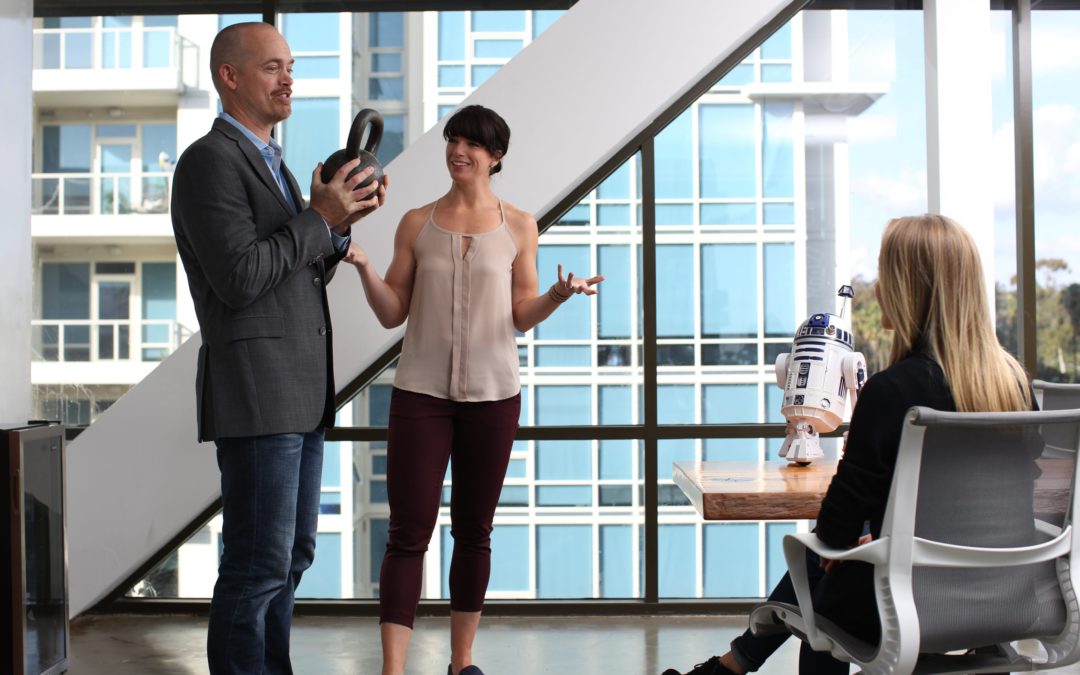Our team recently completed a set of corporate wellness program kickoffs and cohort closeouts at 3 of our clients. Each time we roll out a cohort we learn something about why some organizations’ wellness programs are effective and why others’ just…aren’t.
Remember Terry Tate? Keep him in mind as you read this.
The 5 reasons your corporate wellness program isn’t working are listed below. Explanations for each of the 5 follow the list.
- You provide digital options when what your people are craving is human connection.
- The messaging and recruitment is controlled by administrators, not marketers.
- You don’t have a Terry Tate in a Terry Tate position.
- Your program isn’t actually a cohesive program.
- The organization’s leadership fails to lead by example.
Reason #1: Digital is Nice, but Less Effective than Expectations from an Expert
Here’s our data from the last 3 years of corporate wellness program cohorts.
- 27% of participants on a digital-only program complete the cycle
- 86% of participants on a digital + targeted high touch program complete the cycle
- 87% of participants on a digital + extensive high touch program complete the cycle
- Those that complete a cycle show an average improvement of 19 points on our health risk index, whereas those that do not complete the cycle improve by just under 3 points on that index.
Digital is all the rage. Digital solutions do scale easily to meet the needs of larger organizations. With quality gamification, digital solutions get off to promising starts. But we’re talking about flesh and blood humans, particularly humans in need of behavior change. Digital alone does not create lasting change.
Just like with your kids you wouldn’t simply turn on the TV or give them access to the ipad and consider your parenting done, your employees’ wellness is not improved by simply giving them access to online tools. Someone – a vendor, manager, a Terry Tate – needs to be the figure they are looking to impress (subconsciously or otherwise).
Think of times when you effectively changed behavior IN A WAY THAT LASTED. I bet they almost invariably involved some other human who had expectations of you. An easy example for me was learning to become a quarterback. Coach Underwood drilled mechanics and mindset into me, and when he wasn’t around his voice and visage were present in my head. They still are. I can still execute the footwork for an efficient 5 step drop back, and I still focus on exhibiting poise for the benefit of my team when in the midst of chaos. I’m that way because of Coach.
As a wellness vendor, we hoped digital only would be a hit. The operational and financial risk-reward calculus is much better than a model of staffing up with experts. However, our data tells us we are doing our customers a disservice if we don’t provide some high-touch components. Those components don’t need to be excessive, though. In the case of our digital + targeted high touch program options, those high-touch moments include a) an in-person kickoff workshop with an expert, b) an in-person musculoskeletal health (MH) movement assessment on Day 1, and c) a that same assessment at the end of the cycle.
Reason #2: Wellness Communications is for Marketers, not Administrators
A core component of corporate wellness program success is awareness and recruitment. However, the message that gets to employees is often muted, sent through insufficient channels or reduced to a couple of one-size-fits-all announcements.
It is common for companies to have an internal communications team to serve as the gatekeeper for messaging. The result is often a throttled, singular message that gets sent out in an email with 3-4 other announcements. Any digital marketer will tell you that a GOOD email open rate for a mix of cold and warm leads is 25%, and a GREAT response rate is 6%. And that’s with a targeted, singular message. It’s no different for company-wide missives. Email alone means any program will not be as successful as it could be.
There’s an adage in Sales and Marketing that it takes 7-13 touches for a prospect to finally take action. The only way to engage a prospect that many times is through multiple channels. In addition to email, successful wellness program recruitment messaging uses Slack, SMS, posters, mail-drops, announcements in meetings, social media posts, vendor workshops, etc. As a point of comparison, SMS open rates are currently at least 90% with an average response rate of 45% (9x that of email).
Finally, just as with any base of prospects, potential participants should be segmented so they can be led along a wellness journey, similar to the Customer Journey your company’s marketers work so hard to create with prospective clients. The message and program offering for someone at high risk or who has never participated in a company wellness program before should be different than your wellness regulars.
But would you like to know the best recruitment tool, hands down? Desk to desk signups with a Terry Tate.
Reason #3: You Don’t Have a Wellness Terry Tate
Who is Terry Tate? If you don’t know, or want a fun reminder, check out the Terry Tate youtube channel https://www.youtube.com/user/ReturnOfTerryTate.
A couple of weeks ago our team travelled to a set of client sites in the Midwest and Southwest to kickoff a month-long challenge. At the beginning of the week we had a paltry total of 26 people signed up, primarily due to the challenges described in Reason #2 above.
Once onsite in each location, our team became Wellness Terry Tates. They planted themselves at water and coffee stations, and went from cubicle to cubicle to introduce themselves. Here’s what most interactions were like:
“Hello, I am Dr. T from Movement Rx. Do you know about the wellness challenge we are stating this week in your office?”
“No, I did not, but it sounds awesome.”
“I think you would love it. I cannot wait to see you do it and get your spinal health checked in the process. Let’s sign you up for the program today, starting with your assessment.”
“Yes ma’am!”
Once our team identified the office ringleaders and empowered them, employees began coming in droves to ask questions and sign up. By Thursday there were over 115 people assessed and ready to start the program. Not a huge cohort, but definitely an improvement over 26 people.
It does help that Dr. T looks the part. At 6’1”, fit, and a former US Marine Corps officer, she’s also an expert speaker and musculoskeletal health guru. Employees WANT to say yes to someone like that (back to Reason #1 above).
Companies don’t need a Dr. T type as their Terry Tate. Just someone engaged who walks the talk. Hire from the outside, talk to your benefits consultant, or train someone already in the organization. Part-time or full-time, the point is to have a designated wellness solutions person or team that connects with employees 1-4 times a year on the employee’s specific wellness needs and how to get that employee to engage with programs when they launch. Employees CRAVE this kind of attention to their health.
Your Terry Tate(s) must have real tools, though. That brings me to Reason #4 of why your wellness program isn’t working.
Reason #4: Your program is more hodge-podge of fun choices than path to wellness
Wellness is elective, and so unless yours is a military environment, you cannot ‘voluntell’ people to join a specific program. In response, you offer tastes across the spectrum of physical, financial, mental, emotional and nutritional wellness. You may have even spent considerable time on wellness program design in an effort to map offerings to subjective and objective variables. But chances are that’s not actually solving health issues in your population.
The ideal wellness program elements include
- Clinically proven pathways to serve as curricula for employees
- Curricula that includes in-person and self-directed components
- Team-based and cohort-driven program structure to create and harness collaborative and competitive inertia
- Integrated assessments to identify which curricula and what stage of that curricula an employee should enter
- A one-to-many personal relationship structure as suggested in Reason #3 above
- A movement improvement focus.
That last point is the actual secret sauce. Our philosophy for improving movement (see HERE for my previous thoughts on this) reduces pain, improves human function, provides downregulation tools to respond to stressors, and produces confidence breakthroughs.
We have tons of data to back this up, but stories like the below are more compelling.
A 58 year old civilian has been on our Movement is My Rx program for 3 months. Prior to the program he had not worked out in 15 years due to knee pain. Inactivity for that long meant he had a number of co-morbidities, including being pre-diabetic and possibly hypertensive. We assessed him, fixed a few faulty movement patterns, engaged him in a social class setting, and here’s what he told us recently, “I feel younger, I feel happier, and my knee pain is almost all gone!” According to our assessment index, he is no longer at significant injury risk.
So that brings us to Reason #5, which unfortunately trumps Reasons #1-4 – the actions of company leadership.
Reason #5: Wellness isn’t ACTUALLY a priority for company leadership
So company leadership says wellness is a priority. But the program budget is MAYBE $10 per month per employee. Messaging gets throttled. Managers aren’t bought in and create friction, impacting participation and employee health choices.
Total mismanagement of a strategic opportunity.
In the Affordable Health Care Act era, healthcare responsibility is increasingly being shifted to the employer. So how can company leadership manage that risk and turn it into an opportunity? A start is recognizing that the vast majority of musculoskeletal pain – 96% in the case of low back pain – is completely avoidable.
What’s in the top 4 of nearly every company’s health claims data? Low back pain.
What’s also in the top 4? Mental health.
In our clinical physical therapy work with both chronically ill and healthy populations, we have seen that physical pain and mental health are intertwined, for reasons beyond the scope of this article.
The point? Investment in wellness can create a strategic and sustainable competitive advantage.
Let’s look at that from a different angle. What if employee health was a balance sheet item, with poorer health increasing company liabilities (or reducing assets, depending on who decides the company chart of accounts). How would the value be marked?
In 2015 the Centers for Disease Control (CDC) determined that productivity losses due to health issues cost companies an average of $1,685 per employee. That does not include actual hard dollar costs from health claims or premium adjustments charged by insurers. For a 2,000 employee organization with a typical wellness program, that’s a hefty $3.3 million liability.
How much would your company invest in wellness to reduce this liability?
Wellness leadership starts at the top. Through actions, not words. A powerful wellness program is strategic advantage. A loving, caring culture leads to higher employee satisfaction and better employee health. It follows that every other strategic decision that relies on personnel is enhanced by a healthier and more engaged workforce.
What’s working or not working in your wellness program? Email me at per.larson@movement-rx.com. I definitely want to know.
Latest posts by 5dmin (see all)
- 5 Reasons Why Your Corporate Wellness Program Is Not Working - June 13, 2019
- The Power of Assessments - May 9, 2019
- Healthcare and Fitness Partnerships - April 10, 2019






